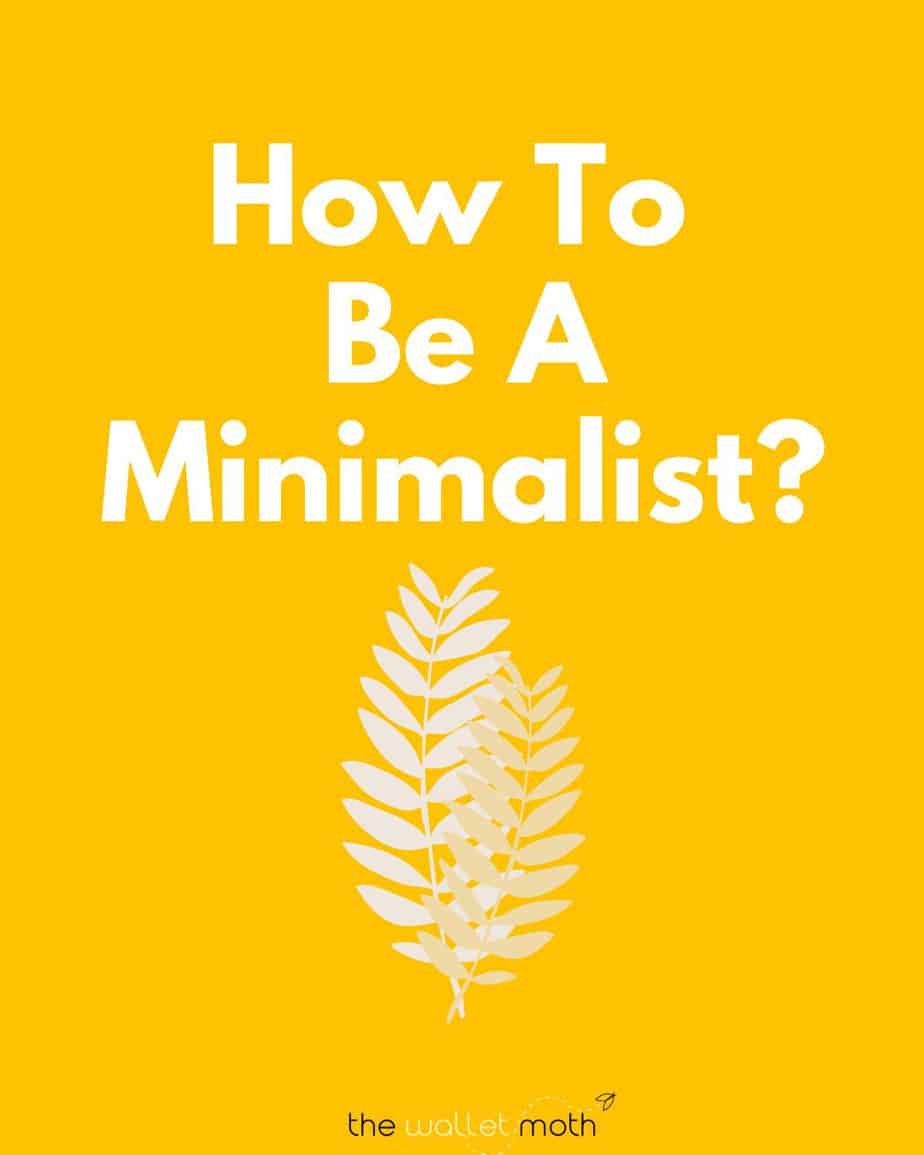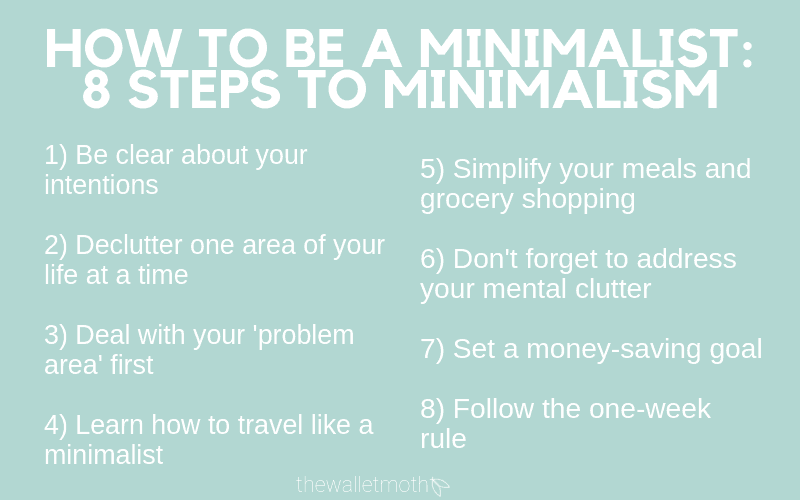We may earn money or products from the companies mentioned in this post, and as an Amazon Associate I earn from qualifying purchases. Please see my full disclosure for more information.
Have you been feeling the urge to rid yourself of the clutter in your life? To go through life with less baggage all around you? This step-by-step guide provides several crucial steps on how to be a minimalist, declutter your life, and begin to love living with less stuff.!

Do you find yourself looking around your home and thinking, why do I have so much stuff?
By now, you’ve no doubt heard about minimalist living – whether that’s thanks to trendy Instagram interior trends or -ahem- a certain series that hit Netflix a couple of years ago.
Honestly, though, we’ve been seeing a lot of maximalism in the mainstream recently. With the reoccurrence of 90s fashion and bold, vibrant colors and patterns coming back into favor in interior design, the minimalist palette might not be for everyone.
Being a minimalist seems like a foreign concept when you’re first considering this lifestyle – and fairly so.
You might look at the vibrant hues and bold color charts of a maximalist Pinterest board and think that looks way more inviting than the neutral, simple hues of a minimalist-inspired home.
Beyond that though, minimalism is so much more than just about colors and design. It’s a way of life. It’s a system for creating less clutter – physically, mentally, financially…everything.
But, where to start? This is a pretty good place. This post is completely dedicated to showing you how to be a minimalist with these 8 steps to minimalism.
Simple.
Acorns is a saving and investing app that makes investing easy. Unlike other investing apps where you pick and choose stocks you want to invest in, Acorns does that for you by recommending a diversified, expert-built investment portfolio of ETFs designed for long term investing.
You'll get a $5 $20 bonus signing up with our link.
What is minimalism?
Minimalism means bringing intention into the way you live, and the way you spend your money. It means knowing your priorities in life and acting accordingly with your physical space, finances, your lifestyle, and everything.
It’ way of living – being comfortable with fewer things around you because you recognize what you really need and want. You appreciate what each thing you own does for you. Minimalism provides freedom from the consumer culture that can feel impossible to avoid at times.
Each person will have their own definition of minimalism and what it means to them.
You might just be looking to declutter one tiny aspect of your home, or you might be ready for a total transformation (although be warned, if you’re the former – I’d wager you’ll become the latter sooner or later!). The goal of minimalism isn’t to eradicate all extra stuff from your life – it’s just about finding a balance, accepting and embracing living with less.
What is the minimalist lifestyle?
With this definition in mind, the minimalist lifestyle is about shaping your life around the things that bring you genuine value and decluttering the other aspects of your life. A minimalist lifestyle doesn’t have to mean living on the bare necessities: instead, it’s about finding the things that are actually important to you and acting intentionally to remove the habits that you could really live without.
What are the benefits of minimalism?
A minimalist lifestyle can bring a lot of value to your life. First, it enables you to identify things you currently spend your money on that you could live without, allowing you to be much better off financially.
It allows you to appreciate your sentimental items, but draw an easy boundary around what you need, what you value, and what new items will actually add something to your life.
Secondly, minimalism totally flips your perspective on how you live your life. A minimalist mindset places a focus on things you value and your happiness – with those things at the forefront of your life, you’re already rich.
Other benefits to minimalism…
- Clarity: Minimalism brings focus and decluttered spaces for productivity.
- Stress reduction: Minimalism reduces overwhelm and materialistic pressures.
- Financial freedom: Minimalism leads to mindful spending and financial stability.
- Time optimization: Minimalism prioritizes meaningful activities and relationships.
- Mindfulness: Minimalism fosters gratitude and appreciation for simplicity.
- Enhanced well-being: Minimalism promotes fulfillment and contentment.
- Sustainability: Minimalism supports eco-friendly practices.
- Improved decision-making: Minimalism simplifies choices and reduces distractions.
- Increased mobility: Minimalism enables freedom and flexibility in movement.
- Inner peace: Minimalism cultivates serenity and balance in life.
Minimalism vs Maximalism
Whereas minimalism embraces simplicity, maximalism is the complete opposite. Maximalism centers on bright colors, and bold patterns, in things everywhere. The comparison can mostly be seen in terms of interior design.
How I Became A Minimalist
In late 2016, I decided my freelance business was at a stable enough point where I could leave my office job and start traveling while slowly building my business at the same time.
This led to a very short time period in which I had to reduce my belongings from an entire house to, essentially, a backpack.
After coming face to face with how much clutter – useless, unnecessary clutter – I owned, I vowed never to let my belongings accumulate to that level again. And honestly? I haven’t.
That being said, when I first start writing about minimalism I was a single person who had just come home from traveling with a backpack for 12 months straight.
Now, in 2023, I have my own home and a toddler and admittedly many more things – but I still like to practice my core foundations of minimalism discussed below.
This is a lifestyle that can still work for a lot of people in different ways, on multiple levels and for multiple circumstances.
How do I switch to a more minimalist lifestyle?
Go at your own pace – don’t feel like you need to declutter each and every aspect of your life immediately. Creating a habit takes time, so switch to a minimalist lifestyle slowly and by addressing the areas that you feel need the most attention. You have so much time to build this into a sustainable lifestyle!
Find your own path, at your own pace.
How To Be A Minimalist

1) Be Clear About Your Reasons
Know why you want to become a minimalist and pursue this lifestyle.
Is it because you have too many material things and not enough space?
Are you spending more than you earn on a regular basis?
Are you in debt and struggling to climb out?
Do you feel constantly stressed because of the cluttered home around you? Do you just want to own fewer items and keep that habit up in the future?
Whatever your reasons, perhaps try writing them down to keep you accountable. If one day you feel yourself slipping back into old habits, look at what you wrote to remind yourself why you want to make a change. It’s a quick, easy way of re-grounding yourself to your intentions.
Read more about living a more intentional life for some simple (but super interesting) tips on building this into a fundamentally helpful habit.
Personally, I love having my own planner so I can jot down my ideas, goals, and reasons for making changes in my lifestyle. There’s something so much more personal about putting pen to paper in these circumstances.
2) Declutter One Zone At A Time
Attempting to declutter your entire home in one go is likely to be far too much hassle for now. I definitely wouldn’t recommend doing it the way I did!
Instead, nominate one room to be your clutter-free zone. That could be your bedroom, your living room, your garage, or even just your kitchen table! – any room you feel could benefit from de-cluttering the most.
Set aside a weekend to really focus on making this room your total clutter-free zone for the beginnings of your minimalist home – check out my guide to decluttering for some tips and advice on the decluttering process and the best way to go about it!
Having one room cleared out is also a great way to test whether you really want to become a minimalist and how much having a clutter-free space benefits you. This is a simpler life and a major change for a lot of people – it’s ok if it’s not for you.
Likewise, this tip goes beyond the physical items around you.
You might find that other areas of your life are cluttered beyond your control. Things like,
- Your finances
- Life admin
- Friendships and relationships
- Your approach to organization
- Your mental load
Go one compartment, one step at a time.
3) Deal With Your Worst Area First
When I first decided to cut down on my own clutter, my worst area was my wardrobe (it still is!). I had piles and piles of clothes that never looked tidy, and I probably wore about 30% of my entire wardrobe on a weekly basis.
Even when I regularly sold second-hand clothes on eBay or donated them, I still couldn’t seem to cut down on the number of clothes I had!
Packing up for a trip around the world and being forced to build to most condensed possible capsule wardrobe definitely changed that. I cut down my entire wardrobe to fit inside a backpack (plus a few winter items that I stored with my parents). It was liberating.
Your worst area could be your wardrobe too, or it could be completely different. You could have a penchant for stocking up on way too much food each week. It could be a garage crammed with sports equipment and camping gear.
You could just have far too many household items in general – no niche, no single weakness but a tendency for hoarding.
Find your crux, and address it now. You don’t have to eliminate everything you enjoy, but if you find there is one thing taking up more space and money than perhaps is smart, deal with it first.
The rest will seem easy in comparison.
4) Learn How To Travel Lightly
Rather than traveling with an enormous backpack that had to be checked in for every flight, I traveled with a carry-on-size rucksack. This was crucial for my own minimalist journey because:
a) It made traveling so much easier! If any of you have ever backpacked before, you’ll know the struggle of long, sweaty walks to your accommodation with 20kgs strapped to your back, not to mention getting in everyone’s way at airports and train stations!
b) It helped me keep accountable for the items I had. If I had a huge backpack to take with me, I definitely would have filled it up with useless items adding nothing but weight.
Having a small carry-on (30 liters) made sure I only packed things I really needed or really loved.
I talk a lot more about minimalist travel and exactly what I packed here if you’re interested in learning more.
Learning how to travel lightly not only makes travel far more convenient, but it also shows you how much you can really live without.
5) Simplify Your Meals
So many people end up with an over-packed fridge and throw out food every week simply because they didn’t get a chance to eat it.
By simplifying your meals, you’ll save money by cutting down on the number of ingredients you buy, but you’ll also find it’s a lot less stressful than trying to plan a new recipe every single day.
Being a minimalist with your meals doesn’t mean you have to eat the same meals day in, day out: it just means being more aware of what you’re buying (and cooking), and perhaps adjusting those habits to keep things more simple.
My guide to meal prep has a lot of useful tips for being more frugal with your approach to grocery shopping, building a meal plan, and cooking more efficiently.
More food-related guides that might help:
- Plant Based On A Budget: Grocery List, Cheap Vegan Recipes & More
- What Is A Minimalist Diet? How To Simplify Your Food
- 15 Things To Buy In Bulk & Save Money On Your Bills
6) Clear Your Mental Clutter
Many people – myself included, on a personal level – have found a yoga practice has been instrumental in their journey towards a minimalist lifestyle.
Having practiced since I was 16, I was actually so surprised that I’d never made the connection between a clear and uncluttered mind and a clean, clutter-free physical environment. The two go hand in hand.
If yoga isn’t your thing, however, then don’t fret.
Clearing your mental clutter is all about finding the thing that gives you headspace and a way of re-setting your day.
If you want to know how to be a minimalist, in my opinion, one of the most important things to do is to look inwards just as much as you address what’s around you.
7) Set A Savings Goal
Having a security blanket of savings makes everything so much more simple. Being a minimalist isn’t easy when you’re stressing about debt repayments and not having enough to cover emergencies.
Set yourself a goal to save a certain amount of money each month. That could be an extra $50, or an extra $500 – whatever works for your circumstances.
Getting better at managing your money is an essential part of being a minimalist, and a skill everyone should be consciously trying to improve.
8) Follow The One-Week Rule
Once you’ve decluttered your home, your next obstacle is making a habit and avoiding re-introducing more stuff into your life.
One of my best tips to create this habit is to follow what I like to call ‘the one-week rule’. This is where if I’ve been shopping online or thinking about buying something that’s not essential, I’ll close my browser and wait about a week.
If after a week I still really want that thing, I’ll buy it.
However, more often than not, a week goes by and I completely forget about that impulsive moment!
This is a super simple but really effective way to cut down on your spending and save your money for things that will really add value to your life.
“The intention of voluntary simplicity is not to dogmatically live with less. It’s a more demanding intention of living with balance. This is a middle way that moves between the extremes of poverty and indulgence.”
– Duane Elgin
Psst…! Ready for a serious clear out? While you’re here, be sure to grab your FREE download of my total home declutter checklist! To get instant access to this printable, simply click here and you’ll also be granted exclusive access to my Freebie Library.
I hope these tips have given you a better insight into how to become a minimalist – good luck!
